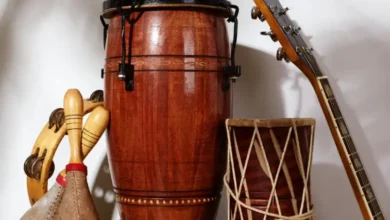From wedding cakes to festival feasts — discover how sweets and desserts carry deep symbolic meaning in global celebrations. Explore the cultural, spiritual, and emotional power of sugar across continents.
More Than Just Sugar — Desserts as Cultural Symbols
Across every continent and culture, one truth remains universal: when people celebrate, they sweeten the moment.
Whether it’s a towering wedding cake in the West, syrup-drenched baklava at a Middle Eastern feast, or sticky mochi offered to Shinto gods in Japan — sweets and desserts are never just treats. They are symbols of joy, prosperity, unity, and divine blessing.
In cultural celebrations — from religious rituals to life milestones — desserts play a starring role. They carry ancestral recipes, spiritual meanings, and communal hopes. In every bite, there’s history. In every sprinkle, there’s symbolism.
See also From Feast to Fasting: Food in Rituals of Purification and Renewal
From Feast to Fasting: Food in Rituals of Purification and RenewalLet’s take a global journey through the sweet side of human celebration.
💍 Sweets in Weddings: Love, Luck, and Longevity

🇬🇧 Western Wedding Cakes — Layers of Tradition
The multi-tiered white wedding cake isn’t just Instagram bait — it’s steeped in symbolism:
- White icing = purity (Victorian-era influence)
- Stacked tiers = prosperity and social status
- Cutting the cake together = first shared task as a married couple
🍰 Fun Fact: The tradition of saving the top tier for the couple’s first anniversary began in 19th-century Britain — a symbol of fertility and future abundance.
🇮🇳 India: Mithai for Marriage
In Hindu, Sikh, and Muslim weddings across South Asia, mithai (sweets) are essential:
See also Globalization and Fusion: How Modern Influences Reshape Traditional Food Rituals
Globalization and Fusion: How Modern Influences Reshape Traditional Food Rituals- Laddoos & barfis symbolize sweetness in married life
- Jalebi’s spiral shape = eternity of love
- Distribution to guests = sharing joy and blessings
No Indian wedding is complete without mountains of colorful, cardamom-scented confections.
🇯🇵 Japan: Kagami Mochi & Saké-infused Sweets
Traditional Shinto weddings may include kagami mochi — stacked rice cakes symbolizing longevity and harmony. Modern Japanese weddings also feature matcha cakes or sakura-flavored desserts, blending aesthetics with auspicious meaning.
🎉 Festival Sweets: Celebrating Seasons, Harvests, and Miracles

🌙 Eid al-Fitr (Muslim World) — Sweetness After Sacrifice
After a month of Ramadan fasting, Muslims break their fast with dates — then dive into celebratory desserts:
- Baklava (Middle East/North Africa) — layers of filo, nuts, and honey = richness of divine reward
- Sheer Khurma (South Asia) — vermicelli pudding with milk and dried fruits = abundance and community
- Ma’amoul (Levant) — date- or nut-filled cookies shaped in wooden molds = heritage and craftsmanship
🌙 Symbolism: Sweets represent the “sweetness” of spiritual victory and gratitude after discipline.
🪔 Diwali (India & Hindu Diaspora) — Light, Wealth, and Sugar
The “Festival of Lights” is also a festival of sweets:
- Laddoo, jalebi, gulab jamun — offered to deities and shared with neighbors
- Sweets as prasad (blessed food) — connecting the divine and the domestic
- Giving mithai = spreading prosperity and goodwill
Sugar here isn’t indulgence — it’s auspiciousness made edible.
🧨 Lunar New Year (China & East Asia) — Sweet Beginnings
Desserts eaten during Lunar New Year are chosen for homophonic symbolism (words that sound like lucky phrases):
- Nian gao (sticky rice cake) — sounds like “higher year” = growth and promotion
- Sweet red bean buns — red = luck, round shape = unity
- Pineapple tarts (Southeast Asia) — “ong lai” in Hokkien = “fortune come”
✝️🙏 Sweets in Religious Rituals: Offerings, Blessings, and Devotion
🕊️ Christianity: Communion Wafers to King Cake
- Communion wafers — though not “sweet,” symbolize the body of Christ; in some cultures, sweetened versions are used for children’s first communion
- King Cake (Epiphany/Mardi Gras) — hidden baby figurine = luck and responsibility; circular shape = eternal love of God
- Hot Cross Buns (Good Friday) — spices = embalming of Christ; cross = sacrifice
🕉️ Hinduism: Prasad — The Divine Sweet
In temples and home altars, devotees offer and receive prasad — blessed food, often sweet:
- Laddoo offered to Ganesha — remover of obstacles, lover of sweets
- Kheer (rice pudding) — served during pujas and festivals, symbolizing nourishment from the divine
- Distribution of prasad = spiritual equality and grace
☪️ Islam: Dates, Halva, and Hospitality
- Breaking fast with dates — following the Sunnah (tradition) of Prophet Muhammad
- Halva at funerals or commemorations — symbolizing the sweetness of the afterlife and community support
- Offering sweets to guests = sacred hospitality (diyafa)
🌍 Global Spotlight: Iconic Celebration Desserts & Their Meanings
| Tres Leches Cake | Latin America | Birthdays, Weddings | Abundance (3 milks = triple blessing) |
| Mooncakes | China | Mid-Autumn Festival | Family reunion, completeness (round shape) |
| Knafeh | Palestine/Levant | Weddings, Eid | Stretchy cheese = enduring love; syrup = sweetness of life |
| Rosca de Reyes | Mexico/Spain | Epiphany | Hidden baby = finding Christ; sharing = community |
| Pastel de Nata | Portugal | Everyday & Festive | Legacy of monastic tradition; caramelized top = resilience through fire |
🍯 Why Do Cultures Sweeten Celebrations?
1. Sugar = Joy, Abundance, and Blessing
Historically rare and expensive, sugar was reserved for special occasions — making it a natural symbol of luxury, divine favor, and communal wealth.
2. Sweets Create Shared Experience
Breaking, sharing, and feeding each other sweets fosters connection, equality, and intimacy — whether among family, friends, or strangers at a festival.
3. Desserts Encode Identity
Recipes passed down through generations become edible heirlooms — preserving language, technique, and memory.
🍰 “We don’t just eat dessert — we taste our grandmother’s hands, our village’s soil, our ancestors’ prayers.”
📸 Modern Trends: Fusion, Revival & Digital Sharing
Today, traditional celebration sweets are being:
- Reimagined (matcha croissants, vegan mooncakes)
- Globalized (baklava in Brooklyn, mochi in Milan)
- Digitally preserved (#DiwaliSweets, #EidTreats trending on Instagram/TikTok)
Yet, at their core, they remain ritual objects — not just content.
Chefs and home cooks alike are reclaiming ancestral recipes — not for trends, but for truth, healing, and continuity.

❓ FAQs: Sweets in Cultural Celebrations
❓ Why are sweets so common in religious rituals?
Sugar historically symbolized divine blessing and purity. Sharing sweets also reinforces community and equality before the divine.
❓ What’s the most universal celebration dessert?
Wedding cake (West) and sweet rice/milk puddings (Asia, Middle East) are among the most globally widespread.
❓ Can desserts really carry spiritual meaning?
Absolutely. In many traditions, food offered to deities (prasad, naivedyam, qurban) becomes spiritually charged — and consuming it is an act of devotion.
❓ How can I honor cultural desserts respectfully?
Learn the story behind the dish. Source authentic recipes. Credit origins. And — most importantly — share with gratitude, not appropriation.
Conclusion: The World Celebrates on a Spoon
From the first bite of birthday cake to the last morsel of festival halva, sweets are more than indulgence — they are intention.
They mark transitions.
They honor gods.
They unite generations.
They turn sugar into story.
In a world that often moves too fast, the ritual of sharing a culturally meaningful dessert invites us to pause, taste, remember — and belong.
So next time you raise a spoon, fork, or sticky finger — know that you’re not just eating dessert.
You’re tasting history.
You’re joining a global chorus of celebration.
You’re keeping culture alive — one sweet bite at a time.




